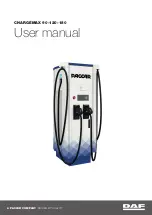
increments for each axle setting. XX = the vehicle’s cold
placard pressure values for the front and rear axles as
shown on the vehicle placard pressure label.
The customer may also store the pressure values cho-
sen for each axle in the radio as a preset pressure. The
customer will be allowed to store up to two sets of pre-
set values in the radio for the front and rear axle pres-
sure values.
Once the customer selects the tire pressures for the
front and rear axles that they want to inflate or deflate
to, they can begin inflating or deflating one tire at a
time.
NOTE:
The STFA system will only support inflating or deflating
one tire at a time.
The system will be activated when the TPM receiver
module detects a change in tire pressure. The ignition
must be in the RUN mode, with the transmission in
PARK (P).
The hazard lamps will come on to confirm the vehicle is
in Tire Fill Alert mode.
If the hazard lamps do not come on while inflating or
deflating the tire, the TPM sensor may be in a inopera-
tive position, preventing the TPM sensor signal from
being received. In this case, the vehicle may need to be
moved slightly forward or backward.
When Tire Fill Alert mode is entered, the tire pressure
display screen will be displayed in the instrument
cluster.
Operation:
•
The horn will chirp once when the selected pressure
is reached to let the user know when to stop inflat-
ing or deflating the tire.
•
The horn will chirp three times if the tire is over
inflated or over deflated and will continue to chirp
every five seconds if the user continues to inflate or
deflate the tire.
•
The horn will chirp once again when enough air is
added or removed to reach proper selected pres-
sure level.
Tire Pressure Information System (TPIS)
3500 Series Trucks
Your vehicle may be equipped with a Tire Pressure Infor-
mation System (TPIS).
The Tire Pressure Information System (TPIS) uses wire-
less technology with wheel rim mounted electronic sen-
sors to transmit tire pressure levels. Sensors mounted
to each wheel as part of the valve stem transmit tire
pressure readings to the receiver module.
NOTE:
It is particularly important for you to check the tire pres-
sure in all of the tires on your vehicle monthly and to
maintain the proper pressure.
The TPIS consists of the following components:
•
Receiver module
•
Four TPM sensors (Single Rear Wheel (SRW)
applications)
•
Six TPM sensors (Dual Rear Wheel (DRW)
applications)
•
Pressure display in the instrument cluster
The TPIS will display all four (Single Rear Wheel (SRW)
applications) or six (Dual Rear Wheel (DRW) applica-
tions) tire pressure values in the instrument cluster
display.
If a system fault is detected, the instrument cluster will
display a "SERVICE TPM SYSTEM" message for a mini-
mum of five seconds and then display dashes (- -) in
place of the pressure value to indicate which sensor is
not being received.
If the ignition switch is cycled, this sequence will repeat,
providing the system fault still exists. If the system fault
no longer exists, the "SERVICE TPM SYSTEM" message
will no longer be displayed, and a pressure value will
display in place of the dashes. A system fault can occur
due to any of the following:
•
Signal interference due to electronic devices or driv-
ing next to facilities emitting the same radio fre-
quencies as the TPM sensors.
•
Installing aftermarket window tinting that contains
materials that may block radio wave signals.
•
Accumulation of snow or ice around the wheels or
wheel housings.
•
Using tire chains on the vehicle.
•
Using wheels/tires not equipped with TPM sensors.
General Information
The following regulatory statement applies to all Radio
Frequency (RF) devices equipped in this vehicle:
This device complies with Part 15 of the FCC Rules and
with Innovation, Science and Economic Development
Canada license-exempt RSS standard(s). Operation is
subject to the following two conditions:
1. This device may not cause harmful interference, and
2. This device must accept any interference received,
including interference that may cause undesired
operation.
130
SAFETY
















































